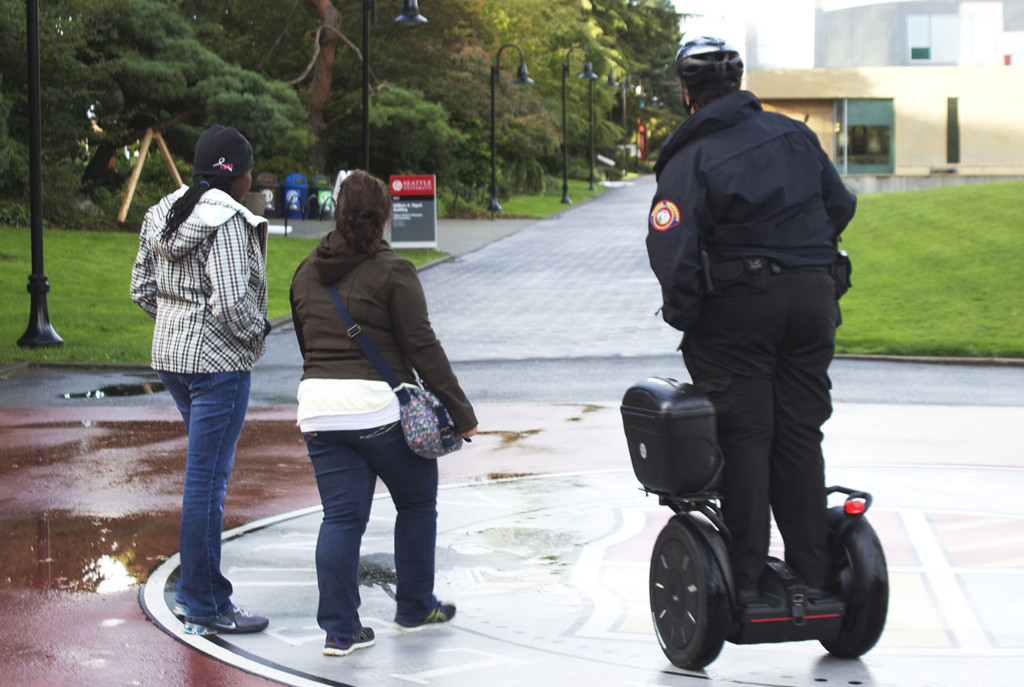Students returning to Seattle University for fall quarter probably noticed a new addition to Public Safety’s arsenal: Segways.
Seattle U Public Safety officers are riding Segways as an alternative to foot or bike patrol in order to increase efficiency. Although it may look like a scene from “Paul Blart: Mall Cop,” there’s nothing funny about the reasons behind the switch to Segways and the changes that this shift
could bring.
When Executive Director of Public Safety Tim Marron was hired three months ago, he noticed a major flaw in the way that Public Safety officers were patrolling campus.
“Coverage was very sparse and understaffed. At that time we had a supervisor and three officers on duty at any given moment,” he said.
But with one of the three officers on dispatch, this meant that with required breaks, there were times that only one officer was actively patrolling throughout the entire campus.
Seattle U acknowledged the understaffing issue and increased the number of Public Safety officers. An inflation of staff size, however, still left only a few officers on patrol at any given time.
Given the size of campus, designing effective patrol was no easy task. Mountain bikes shortened response times, but patrolling on a mountain bike for a 12-hour shift can be exhausting. In addition, bikes don’t allow access to buildings.
“[The increase in staff] helped,” Marron said. “But at any given moment, you have two to three officers now covering the entire campus, so I asked myself, How do I decrease the amount of time that it takes for officers to patrol the outside of campus and inside of buildings? How do we get them there quickly?”
To Marron, the solution was clear; Seattle U should purchase Segways for Public Safety officers.
They allow for quicker response times, sail through buildings and across campus, and help officers to overcome the usual traffic messes that patrol cars have to put up with. With Segways, officers are able to patrol campus much more efficiently, and avoid fatigue.
“The thing with the Segway is it enables officers to get exponentially more patrol inside and outside of buildings, while being able to carry all of their emergency equipment with them on the Segway. The beauty of the Segway is you don’t have the fatigue factor, either,” Marron said. “No matter how in-shape you are, if you’re on a mountain bike for twelve hours, you’re not going to be as effective at the end of your shift as the beginning.”
Marron, who previously implemented the use of Segways at Evergreen State College, is prepared for challenges that might emerge from the change. According to Marron, one of the biggest challenges at Evergreen was student response to Segways. Some students might not understand why patrolling by foot or bike is inefficient, or simply don’t see the need for Segways. Still, some have been able to grasp that the program could have some benefits, particularly after Marron anticipated a tepid response from the student body and sent a campus-wide email describing the program.
“I know that they’re good for carrying equipment, such as defibrillators,” said junior Katie Athis. Athis mentioned that she is glad that Public Safety is interested in educating students about the Segways and even letting students try out the Segways on campus.
The officers themselves are also excited about the change. According to officer Joshua Halbert, riding the Segways can take a bit of getting used to because of the toll of standing, but officers are impressed by the improved response time that the Segways provide.
Marron understands that students are concerned about how the school spends tuition money, and because of this, he is making an effort to educate students on the importance of the Segways. Marron sent an explanatory email to students and staff this summer, and has planned demos that offer students the chance to try the Segways out for themselves.
“Our mission is to protect lives and property, and our officers have changed their mindsets to the focus of the mission,” Marron said. “The use of Segways is just one way that we’re trying to accomplish that shift of philosophy.”








